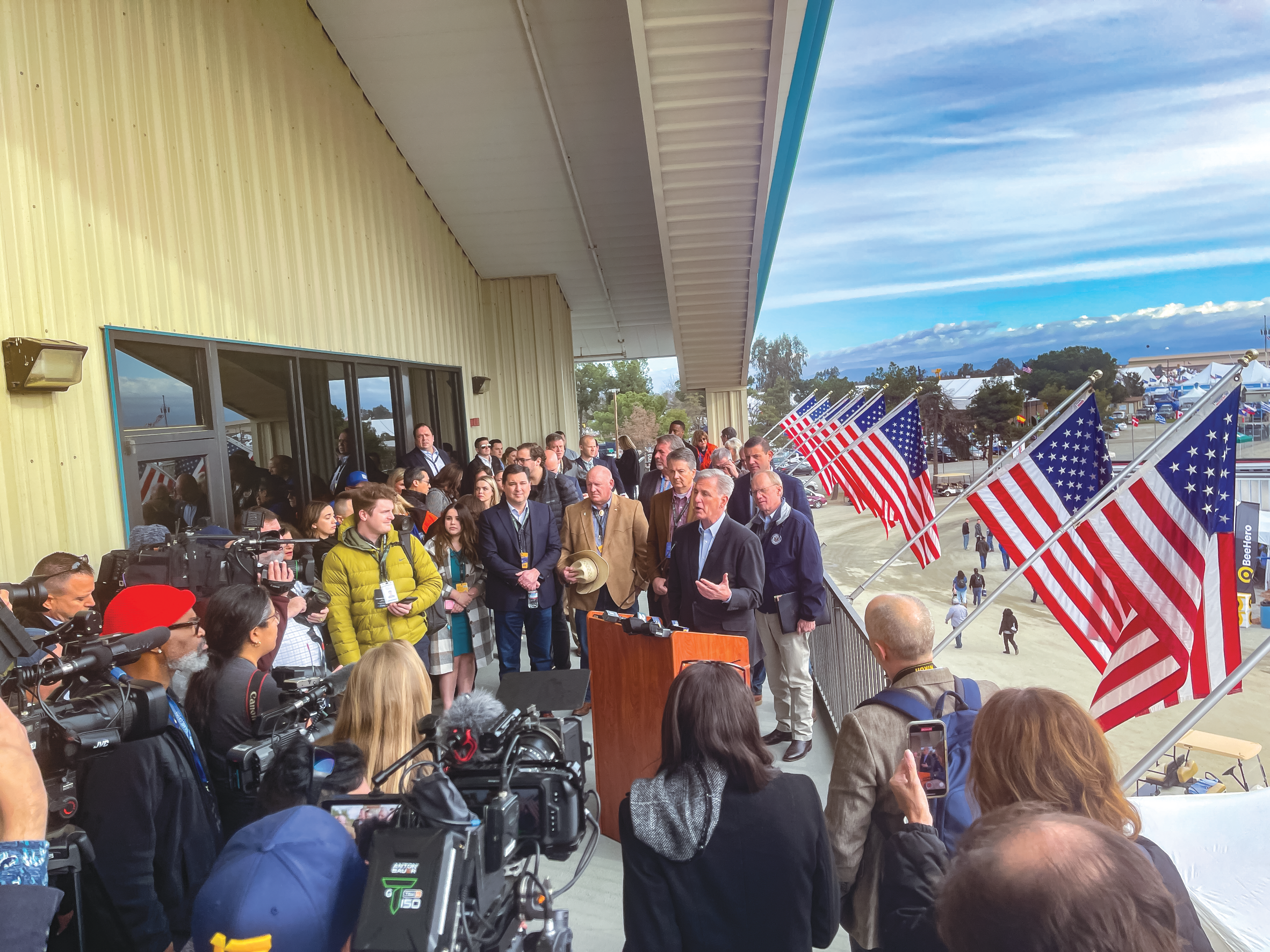Farmers address House panel at Ag Expo

The nation’s 2023 Farm Bill took center stage at the World Ag Expo in Tulare last week, as farmers engaged with members of the House Agriculture Committee and Speaker Kevin McCarthy, R-Bakersfield.

House Speaker Kevin McCarthy fields questions at the World Ag Expo in Tulare. The farm show also hosted a House Agriculture Committee session, which gathered testimony and ideas for the 2023 Farm Bill. McCarthy promised “to empower our agricultural producers who feed the world.”

By Christine Souza
The nation’s 2023 Farm Bill took center stage at the World Ag Expo in Tulare last week, as farmers engaged with members of the House Agriculture Committee and Speaker Kevin McCarthy, R-Bakersfield.
McCarthy’s appearance at the largest farm show in the world marked the first time a House Speaker attended the event. He joined Committee Chairman Glenn “GT” Thompson, R-Pennsylvania, and six other California representatives. The listening session focused on the omnibus legislation that contains an array of agricultural and food programs, including for nutrition, crop assistance and conservation.
California farmers and farm associations, including the California Farm Bureau, highlighted challenges facing America’s largest agricultural economy, including supply-chain disruptions, labor shortages, inflation and rising input costs.
“For the farmer, those challenges have resulted in economic disruption, tighter margins and even permanently closed farms,” said California Farm Bureau President Jamie Johansson, who farms olives and citrus fruit in Oroville. “There is still much that can be done to help ensure that our family farmers and ranchers have the tools necessary to provide safe, nutritious and affordable food for U.S. consumers as well as nations abroad.”
With the 2018 Farm Bill set to expire in September, the House Agriculture Committee has oversight to craft a five-year farm bill. The Committee chose the World Ag Expo as its first stop to gather feedback. McCarthy said he would like a farm bill that works for farmers in the Central Valley, California and the United States.
“Our products are better. Our opportunities are greater,” McCarthy said. “We need water to make it happen. But, at the same time, we need fair trade, and we need to be able to get in front of diseases, so that is why this is so important.”
Describing the farm bill as America’s safety net, Rep. Jim Costa, D-Fresno, a senior member of the House Agriculture Committee, said “food for all Americans is a national security issue. We hope this year for a successful, bipartisan farm bill because this is about sustainable agriculture.”
Also at the session were California Reps. David Valadao, R-Hanford; John Duarte, R-Modesto; Jimmy Panetta, D-Salinas; Doug LaMalfa, R-Richvale; and Salud Carbajal, D-Santa Barbara.
Some at the event emphasized the need to support farmers with risk management tools, including federal crop insurance.
Less than a quarter of California’s 400 commodities are covered by crop insurance programs, Johansson said. To recover from losses, producers have had to rely on significantly delayed ad hoc federal funding, he said, adding that many have waited nearly three years to see any form of support from the Emergency Relief Program.
“It should go without saying that many family businesses simply cannot afford to wait so long,” Johansson said. “This farm bill should prioritize development of new crop-insurance tools for uncovered producers as well as improvements to existing tools in a practical, affordable way regardless of commodity and farm size.”
To this point, Gary Martin, a cotton farmer from Firebaugh, said since the passage of the 2018 Farm Bill, ad hoc assistance has been authorized to address weather-related crop disasters and extreme price declines caused by the COVID-19 pandemic and trade retaliatory measures.
“The increase in costs in our crop translates into a significant decline in the effective safety net offered by the Price Loss Coverage price,” Martin said. “It is critical that the ag committees have the funding necessary to address these challenges in the next farm bill.”
Tipton dairy farmer Jared Fernandes told the House panel that safety net programs and federal crop insurance are key to creating a predictable operating environment for farmers.
“We need Congress to maintain strong support for these programs and fend off any cuts,” Fernandes said. “We encourage you to consider updating these programs to make them more effective, increasing reference prices, expanding producer flexibilities and keeping crop insurance affordable to farmers.”
To safeguard crops, some said the farm bill should include plant health protections to strengthen, prevent, detect and mitigate invasive pests and diseases through programs such as the Plant Pest and Disease Management and Disaster Prevention Program and the National Clean Plant Network.
Alyssa Houtby, senior director of federal affairs at California Citrus Mutual, called for continued support to find a cure for the destructive plant disease huanglongbing, also known as “citrus greening,” which is spread by an insect, the Asian citrus psyllid.
“The Central Valley is the No. 1 fresh citrus-producing region in the entire country,” Houtby said. “Over 80% of the U.S. citrus production is right here, and 70% of our total production stays within the United States of America. We ask Congress to continue the Citrus Trust Fund and continue funding it at that $25 million per year amount.”
With more than 70% of California’s almonds exported, Alicia Rockwell, who handles government affairs for Blue Diamond Growers, said the almond sector needs more tools to help with market access, specifically the oversubscribed Market Access Program, or MAP.
“I plead with the committee that this is the year, this is the farm bill that we finally look to getting more dollars put into the Market Access Program,” said Rockwell, who added that Blue Diamond can show there is a $152 return for every MAP dollar invested.
For forest health, forest management, watershed health and mitigation of fire risk through the forestry title of the farm bill, Johansson urged the committee to consider crafting strong forestry language.
“To keep our forests healthy and mitigate wildfire risk to communities and natural resources, the farm bill should seek to address forest health challenges on federal, state and nonfederal lands,” he said.
Some asked that more federal funding be dedicated to agricultural research, which leads to lower costs, improved crop yields and environmental benefits.
Though water and labor are not individual titles of the farm bill, some farmers at the listening session said more must be done, including investing in water infrastructure and passing immigration reform.
McCarthy said members of the House Agriculture Committee have a big job ahead to finish writing the farm bill. He said the farm programs help farmers take the traditions of the past and apply them to a changing future and global economy.
“We realize that competition makes it tougher,” McCarthy said. “But we also realize that if America is given a level playing field, we can compete anywhere and win.”
(Christine Souza is an assistant editor of Ag Alert. She may be contacted at csouza@cfbf.com.)




